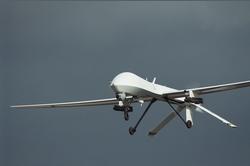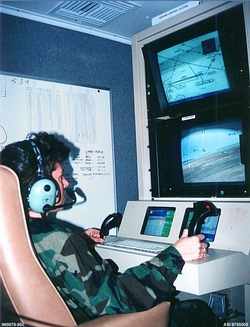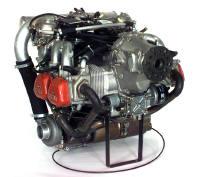'Big Headache' for Enemy
 One of the most formidable aircraft in the
Operation Iraqi Freedom arsenal does not even carry a pilot.
Appearing almost toy-like at a mere 27 feet long, the RQ-1/MQ-1
Predator is an unmanned aerial vehicle that remains a huge headache
for enemy forces.
One of the most formidable aircraft in the
Operation Iraqi Freedom arsenal does not even carry a pilot.
Appearing almost toy-like at a mere 27 feet long, the RQ-1/MQ-1
Predator is an unmanned aerial vehicle that remains a huge headache
for enemy forces.
Operated remotely by a pilot and sensor operator from a
satellite-linked ground control station, the Kevlar-skinned UAV can
remain aloft on marathon missions of 20 hours or more. The Predator
uses its powerful surveillance cameras to give the theater air
component commander continuous real-time surveillance of the
battlefield. Besides its highly potent reconnaissance ability, it
can carry Hellfire anti-tank missiles. The Predator lives up to its
menacing name.
At an air base near the Iraqi border, a particularly important
aspect of the overall weapon system that ensures the Predator lives
up to its deadly reputation -- the maintainers of the 46th
Expeditionary Reconnaissance Squadron. The team includes crew
chiefs and specialists in avionics, ground equipment,
communications, satellite communications, munitions, supply and
contracting. Their efforts are especially noteworthy, given the
extremely high operational demand on their relatively small
Predator fleet.
Reliable Little Bugger
"With the enormous amount of hours we fly, our down time is
almost nonexistent," said Senior Master Sgt. Jeffery Duckett, 46th
ERS maintenance superintendent. "What that means is that everyone
has to perform top-notch maintenance every day to sustain our
wartime taskings. Take away any one of these components, and our
mission effectiveness degrades significantly."
 According to Senior Airman Jason Biselx, a 46th
ERS crew chief, the demands of the 24-7 mission translate to a
challenging maintenance tempo.
According to Senior Airman Jason Biselx, a 46th
ERS crew chief, the demands of the 24-7 mission translate to a
challenging maintenance tempo.
"The main challenge of 24-hour ops with long-endurance missions
is the amount of periodic and phased maintenance needed," said
Biselx, a native of Kaukauna (WI). "Time-change items come up
faster, phases arrive quicker, and major engine overhauls start to
really stack up. During a one-week period early in Operation Iraqi
Freedom, we had major engine overhauls every night. Another key
challenge is fine tuning a small, dual-carbureted engine for
high-altitude, long-endurance flight."
The roughly 1,700-pound Predators are designated RQ-1 in purely
reconnaissance configuration and MQ-1 when carrying munitions.
Duckett, a native of New Orleans, said the single-propeller UAVs
are essentially powered by a glorified snowmobile engine -- a
four-cylinder Rotax 914 powerplant. [Editor's note: although
Bombardier Rotax is indeed a big supplier of engines for
snowmobiles, the Rotax 914 is the turbocharged version of the 912,
which was designed from its inception to be an aircraft engine. The
914 was never intended for snowmobile use.]
Like aeronautical vampires, unassembled Predators are packed in
crates called "coffins," because of their obvious shape. They are
pulled from the "morgue" at Indian Springs Air Force Auxiliary
Field (NV), the unit's home station, and airlifted to the theater
of operations.
Operating at this desert base during the plentiful enemy missile
threats and alarm-red conditions presented the maintainers some
unique challenges in keeping their Predators fully mission
capable.
"It's a long run to a bunker when you're launching an aircraft
from [a distant aircraft shelter] in MOPP 4," said Staff Sgt. Kevin
Strickland, a crew chief. The Beaufort, S.C., native is currently
on his second deployment with the Predator unit for operations
Southern Watch and Iraqi Freedom.
Another challenge facing the maintainers is an environmental
one, thanks to Mother Nature's powerful and frequent sand and dust
storms. But that never halts the action inside the maintenance
hangar.
"If the weather gets a little ugly, and we can't get airborne,
the troops instinctively know to step up the maintenance to take
advantage of this down time, while simultaneously preparing to
launch again the second the weather breaks, Duckett said.
 Learning to adapt to and overcome wartime and
harsh weather conditions is something the maintainers say they can
pass along to their comrades back at Indian Springs.
Learning to adapt to and overcome wartime and
harsh weather conditions is something the maintainers say they can
pass along to their comrades back at Indian Springs.
"I've learned great lessons in teamwork, improvising and
troubleshooting," Biselx said. "There are certain situations and
conditions these aircraft are exposed to that you just don't see at
home station. Experience is gained in leaps and bounds in deployed
locations. It's critical for us to pass along these experiences to
maintain a well-prepared maintenance team."
Duckett summarized a common feeling of pride his maintainers
share in their ultimate role in Operation Iraqi Freedom.
"Just look at the news. (The Iraqi regime has been defeated,)
and rest assured, this unit played a huge role in making that
happen," he said.
[Thanks to Tech. Sgt. Dan Neely, 386th Air Expeditionary Wing
Public Affairs --ed.]
 ANN's Daily Aero-Term (12.19.25): Ultrahigh Frequency (UHF)
ANN's Daily Aero-Term (12.19.25): Ultrahigh Frequency (UHF) NTSB Prelim: Cirrus Design Corp SR22T
NTSB Prelim: Cirrus Design Corp SR22T Classic Aero-TV: The Red Tail Project--Carrying the Torch of the Tuskegee Airmen
Classic Aero-TV: The Red Tail Project--Carrying the Torch of the Tuskegee Airmen Aero-News: Quote of the Day (12.19.25)
Aero-News: Quote of the Day (12.19.25) Airborne 12.17.25: Skydiver Hooks Tail, Cooper Rotax Mount, NTSB v NDAA
Airborne 12.17.25: Skydiver Hooks Tail, Cooper Rotax Mount, NTSB v NDAA





